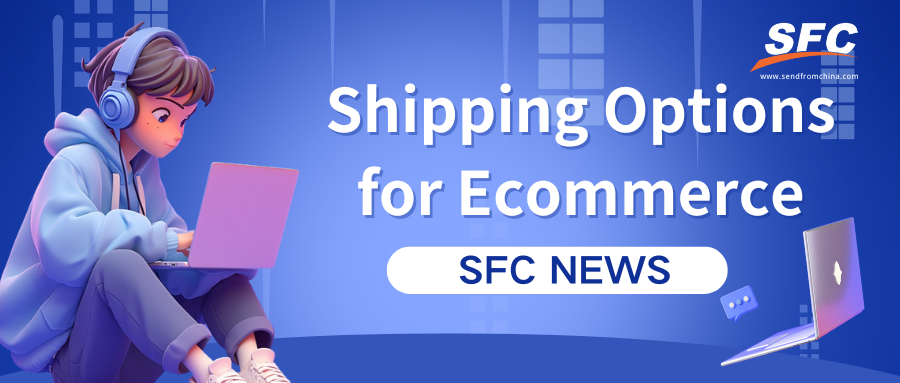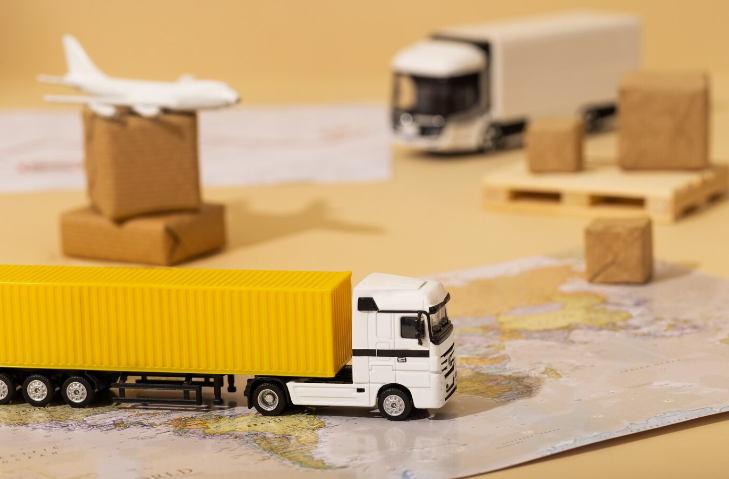Table of Contents
Shipping Options for Your Ecommerce Business
Time: Feb 20,2025 Author: SFC Source: www.sendfromchina.com
As an ecommerce seller, one of the most crucial decisions you’ll make is choosing the right shipping method. It’s not just about getting your products from Point A to Point B. The logistics behind your shipping strategy directly affect customer satisfaction, costs, delivery times, and ultimately, your brand reputation. It is especially important for cross-border ecommerce businesses that operate globally, navigating a maze of regulations, taxes, and delivery preferences across different regions.In this article, we’ll explore the various shipping options available to ecommerce businesses, focusing on the needs of global cross-border sellers. We’ll also break down the options based on different seller types, from small businesses just getting started to established brands looking to expand.

1. Why Shipping Choices Matter for Ecommerce Sellers
Shipping is often one of the most expensive and complicated aspects of running an ecommerce business, particularly when selling internationally. For cross-border sellers, the right shipping strategy can make the difference between happy customers and cart abandonment. Offering various shipping options gives buyers flexibility and can be a competitive advantage.Furthermore, as more customers demand faster shipping and better tracking transparency, it’s essential to choose shipping options that meet these expectations while balancing cost-effectiveness. But before diving into logistics providers, it’s crucial to understand the different types of ecommerce businesses, as each type may have unique shipping needs.
2. Shipping Options for New Ecommerce Sellers

Domestic Shipping Providers: Local Is Key
For sellers in their early stages, focusing on domestic shipping can help streamline operations. Major domestic carriers such as UPS, FedEx, DHL, and national postal services (e.g., USPS in the US or Royal Mail in the UK) offer reliable services at competitive prices.- USPS (United States Postal Service): Excellent for small businesses due to its affordability, especially for lighter packages. International services like Priority Mail International can help with cross-border shipping.
- Royal Mail (UK): A popular option for UK-based businesses, with reliable international services like International Tracked & Signed for affordable delivery.
- Canada Post: For Canadian-based sellers, Canada Post offers a variety of international shipping options, including small packet services and expedited parcel options.
Budget-Friendly International Options for Small Sellers
For businesses operating internationally but with limited resources, it’s important to find a balance between shipping costs and delivery times. Many international sellers rely on platforms like Shipbob to access discounted shipping rates from major couriers. These platforms consolidate volume and provide access to lower rates than most individual sellers could achieve on their own.Another common option for cross-border ecommerce is SFC, which is especially popular among sellers in China (and other countries in Asia) shipping to markets like the United States, Europe, and Australia. SFC offers affordable and relatively fast shipping, typically taking 7-20 days, and includes tracking services.
Fulfillment Services for Small Sellers
Partnering with a third-party logistics (3PL) company can simplify things for sellers who want to offload some of the logistical work. Fulfillment centers like ShipBob or SFC allow sellers to store inventory in centralized locations and ship directly to customers. 3PLs can reduce the time it takes for products to reach your buyers while reducing your administrative burden.3. Shipping Options for Mid-Sized Ecommerce Sellers

Multi-Carrier Shipping Solutions
Mid-sized sellers often face a dilemma: Should they stick with one shipping carrier, or diversify their options? The key here is flexibility. Platforms like SFC give sellers access to multiple carriers, allowing them to choose the best shipping option based on cost, delivery speed, and the destination.Using multiple carriers gives you the ability to adjust your shipping strategy based on the season (e.g., during holidays when demand spikes) and to meet customer expectations across regions. For example:
- FedEx and UPS: Well-known for fast, reliable deliveries, especially for larger items.
- DHL Express: Known for international deliveries, offering a fast track to international markets, particularly in Europe and Asia.
- USPS: Good for lighter, lower-cost shipments in the US.
Shipping Platforms with Global Reach
At this stage, mid-sized sellers might start integrating shipping platforms that help manage multiple carriers and regions. Some of the top-rated platforms for global ecommerce sellers include:- SFC: Specialized in Fulfillment from China to the world, sellers can automate duties and taxes, calculate shipping costs, and provide real-time tracking information across multiple carriers and countries.
- Shippo: Shippo integrates with over 50 carriers, offering transparent pricing and global shipping solutions.
4. Shipping Options for Large Ecommerce Businesses

International Freight Shipping
At this scale, many businesses switch to international freight shipping for bulkier products. Whether by sea, air, or rail, freight forwarding companies like Maersk and DHL can help businesses manage containerized shipments, reduce costs per unit, and streamline cross-border shipping.- Sea Freight: Best for bulk shipments and cost-effective long-distance shipping. However, transit times can take several weeks.
- Air Freight: Faster but more expensive. Air freight is ideal for high-value items or time-sensitive products, with delivery usually within 2-10 days.
Global Fulfillment Centers
For large businesses, partnering with a global network of fulfillment centers can significantly reduce shipping times and costs. Amazon FBA, Rakuten Super Logistics, or ShipBob offer fulfillment centers in key global markets, enabling sellers to store inventory closer to customers.- Advantages: Reduced shipping time, inventory stored locally, access to advanced shipping methods.
- Considerations: High fees for storage and handling, complex inventory management.
China Fulfillment Centers
A China fulfillment center is an excellent choice for e-commerce sellers, especially those manufacturing products in China. A China fulfillment center significantly reduces shipping and operational costs by enabling direct shipments from factories and leveraging China’s affordable labor and logistics infrastructure. Being close to production facilities allows for faster restocking, shorter lead times, and easier quality control, ensuring smoother operations and better inventory management.Shipping Automation Software
Larger ecommerce businesses may invest in shipping automation software to reduce the complexity of managing multiple shipping carriers. These platforms can help automate tasks like customs clearance, duties and taxes, and tracking, making it easier to manage cross-border sales.5. Conclusion
Shipping is a critical component of any ecommerce business, and selecting the right shipping options can make all the difference in achieving customer satisfaction and maximizing profitability. Whether you’re an Amazon seller or a DTC seller, your logistics strategy should be tailored to your specific business needs, customer expectations, and budget.6. FAQs
1. What is the best shipping option for Amazon sellers?
The best shipping option for Amazon sellers depends on the level of control you want over logistics. If you want a hands-off approach with global reach, Fulfillment by Amazon (FBA) is the way to go. It handles storage, packing, and shipping while offering Prime eligibility. If you prefer more control and flexibility, Fulfillment by Merchant (FBM) allows you to handle shipping yourself or with a third-party logistics provider (3PL).2. Can I sell internationally on Amazon?
Yes, Amazon’s Global Selling program allows you to list your products in multiple international marketplaces. This can significantly expand your reach without the need to set up operations in each country. However, you’ll need to manage different VAT regulations and customs requirements.3. What are the advantages of using a third-party logistics (3PL) provider for DTC ecommerce?
Using a 3PL provider allows you to scale your business without having to invest in your own warehouse and fulfillment infrastructure. 3PLs offer global shipping options, inventory management, and packaging services. They can save you time and money, especially if you plan to sell internationally or have a high order volume.4. Is dropshipping a good shipping option for DTC businesses?
Dropshipping is a viable option for DTC sellers, especially if you want to avoid holding inventory. The main advantage is that you only pay for products when an order is placed. However, shipping times can be longer, and you have less control over the packaging and product quality.5. How do I handle VAT and customs for international shipping?
When selling internationally, understanding VAT (Value Added Tax) and customs requirements is crucial. For European markets, you must collect VAT based on the customer’s location. You also need to be aware of duties, tariffs, and the necessary paperwork for customs clearance. Many 3PL providers offer assistance with these processes. Post Views:40
Post Views:40
Copyright statement: The copyright of this article belongs to the original author. Please indicate the source for reprinting.
Previous Post
Next Post
Warehouse Traceability: What It Is & Why It Matters for Ecommece
TAGS
Hot Research
Get a Custom China Fulfillment Solution with FREE Storage for 30 Days
 Want to know about our services, fees or receive a custom quote?
Want to know about our services, fees or receive a custom quote?
 Please fill out the form on the right and we will get back to you within a business day.
Please fill out the form on the right and we will get back to you within a business day.
 The more information you provide, the better our initial response
will be.
The more information you provide, the better our initial response
will be.





 TAGS:
TAGS: